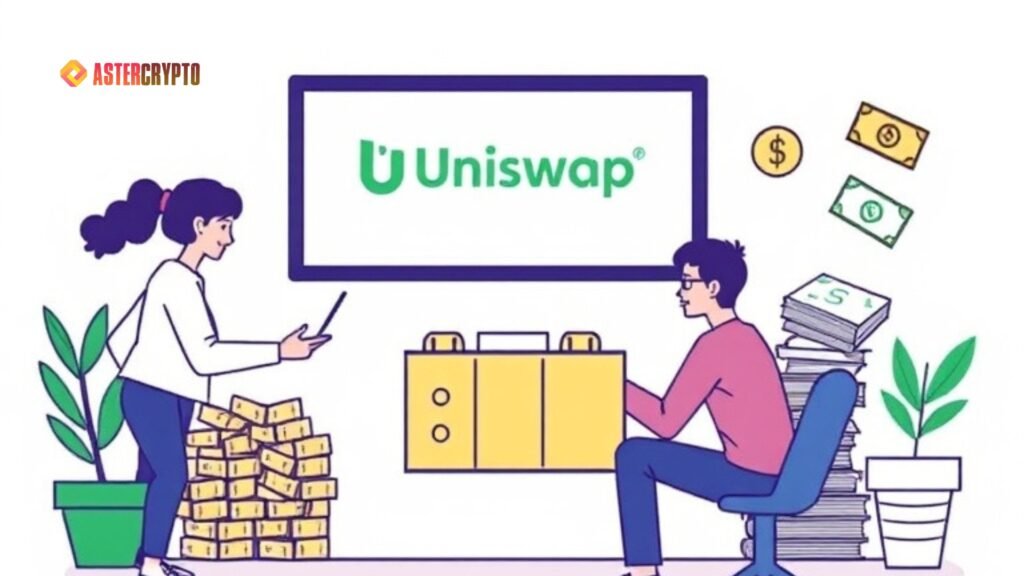The Ethereum-based decentralized exchange (DEX) Uniswap is making waves in the cryptocurrency community with its fresh take on trading. Using smart contracts, Uniswap removes the middleman from digital asset trading, setting it apart from conventional exchanges. Uniswap is a decentralized platform; how can it generate revenue without the usual transaction fees and without a governing body taking a cut?
An analysis of Uniswap’s revenue-generating mechanism follows, emphasizing the protocol’s self-sufficiency and the incentives it offers liquidity providers.
The Basics of Uniswap
It is essential to grasp the platform’s operation before delving into Uniswap’s revenue strategy. Users can trade tokens directly from liquidity pools instead of depending on a traditional order book, thanks to Uniswap’s automated market maker (AMM) mechanism.
Users, known as liquidity providers, put in an equal amount of two distinct tokens to form these liquidity pools. Intelligent contracts implemented by Uniswap guarantee that liquidity providers never run out of tokens that may be swapped, and the value of the pool changes as a result of trades based on the ratio of the two tokens.
“x” and “y” stand for the quantity of the two tokens, and “k” is a constant; this formula is the basis of Uniswap’s design. During transactions, this formula maintains price parity without needing a governing body. What does Uniswap do with the money it makes from this revolutionary approach offering a decentralized platform to support itself?
Transaction Fees: The Core of Uniswap’s Revenue
Uniswap earns a portion of its revenue via transaction fees. Although these payments do not directly benefit Uniswap, they benefit liquidity providers. A cost of 0.30% is applied to every token swap. The liquidity providers are incentivized to contribute capital to the pools by adding and distributing this fee among themselves.

Liquidity providers aren’t the only ones who stand to gain from Uniswap’s protocol; the platform’s administration and future development could also get a cut. Even while this “fee switch” is not enabled at the moment, Uniswap may be able to activate it in the future, meaning that the protocol may keep some of the transaction costs. Beyond simply compensating liquidity providers, this would also provide a direct source of income for Uniswap.
Fee Tiers in Uniswap v3
The third version of Uniswap, released in May 2021, added several pricing categories to the platform. Now, liquidity providers can choose their fee percentage (0.05%, 0.30%, or 1.00%) according to the risk and volatility they are ready to accept for a given token pair. Since Uniswap may adapt to various markets and user types, liquidity provision is always a viable alternative. Future improvements to Uniswap’s governance may make collecting some of these fees possible, though the company does not currently do so.
UNI Token Uniswap’s Native Cryptocurrency

The Uniswap business model relies on the UNI governance currency. Tokens called UNI will be on sale in September 2020 and will give buyers a voice in protocol upgrades, fees, and governance. Investors in UNI coins will not get dividends or monetary benefits. Its price has increased significantly over the years, giving early contributors a return on their investment.
The UNI token may also be involved in Uniswap’s future money-making attempts. The platform’s administration can activate the fee switch stated earlier; UNI holders would have authority over it if so. A treasury that receives a share of the transaction fees can spend those monies as they see fit. Uniswap might generate revenue using this strategy without altering its core decentralized structure.
Liquidity Mining Programs
The liquidity mining operations run by Uniswap also contribute to the ecosystem’s value. Users who add liquidity to the network are rewarded with UNI tokens through these programs, allowing them to participate in the platform’s growth. Uniswap doesn’t get any money from this, but more users are willing to supply liquidity, meaning more trades on the site.
Although it has not yet taken a cut of the trading costs. Uniswap gains indirectly through more significant usage due to its efforts to boost liquidity and attract more traders. By strengthening the platform’s governance and ensuring its long-term survival, liquidity mining campaigns help promote using UNI coins.
Partnerships and Integrations
Through its collaborations and connections with other platforms, Uniswap has become essential to the more considerable decentralized finance (DeFi) ecosystem. Niswap’s trading tools and liquidity pools are accessible directly via these connectors for DeFi protocols. DeFi platforms like Compounds use Uniswap pools. Provide liquidity for decentralized lending and borrowing protocols. However, Uniswap does not levy any fees directly on these platforms. The broader ecosystem benefits from increased trade volume and solidification. Uniswap’s position is a vital component of the DeFi infrastructure.
Token listing projects and developers are drawn to Uniswap due to the platform’s reputation as a trustworthy and open DEX. Since there are no listing expenses, liquidity providers earn more from trading fees due to the enormous number of newly minted tokens.
The Future Revenue Opportunities for Uniswap
Uniswap may have missed particular revenue possibilities up until now, but there are plenty of ways it may improve its financial sustainability in the future:
- Fee Switch Activation: As mentioned earlier, Uniswap could decide to activate its fee switch, allowing the protocol to collect a portion of trading fees. This would enable Uniswap to generate direct revenue while maintaining its decentralized governance structure.
- Layer 2 Scaling Solutions: Uniswap is actively exploring layer 2 solutions like Optimism and Arbitrum, which could reduce transaction costs and attract more users. While these solutions don’t directly impact revenue, they increase the platform’s overall competitiveness and trading volume, benefiting its financial sustainability.
- Institutional Participation: As decentralized finance grows, more investors are looking to DeFi platforms like Uniswap for liquidity. It could significantly boost its revenue potential if Uniswap introduces features catering to institutional investors, such as larger liquidity pools or custom fee tiers.
- UNI Buyback Programs: Similar to stock buyback programs in traditional finance, Uniswap could implement a UNI buyback mechanism where a portion of the fees collected from the protocol is used to buy back UNI tokens. This could increase the token’s value and provide indirect returns to UNI holders.
Final Thoughts
To reward liquidity providers, Uniswap uses transaction fees based on the platform’s decentralized structure. Uniswap is not currently taking any fees directly. Still, it plans to start doing so if the governance approves it, given its unique approach to decentralized trading and focus on community-driven governance. Uniswap is a critical player in the cryptocurrency market and has excellent potential for revenue growth in the DeFi business.
Also Read: Crypto is the Next Election Donation Trend the Reason
[sp_easyaccordion id=”1978″]

